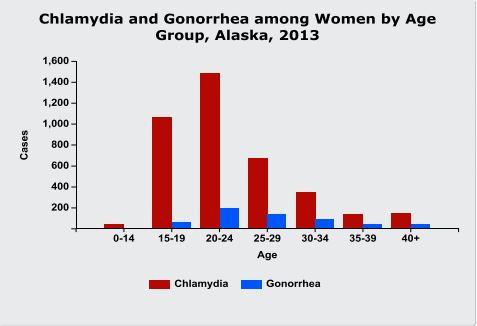
After learning that chlamydia and gonorrhea had pushed Alaska to the lead nationally in STI’s, board member Tom Conley — a physician — said “There’s nothing wrong with our HIV/AIDS policy as presented — it’s just insufficient.” (US Centers for Disease Control image)
The Sitka School Board has sent its policy covering sexually-transmitted infections back to the drawing board.
At its regular meeting Monday night (9-12-16) the board introduced minor language revisions to its policy on HIV/AIDS, but was brought to an abrupt halt by testimony from the public.
Lauren Havens, the district liaison for Sitkans Against Family Violence, thought the schools were missing the boat on the STI’s, or sexually-transmitted infections, most prevalent today.
“(Alaska is) number one in the country for chlamydia, number four in the country for gonorrhea, and number 46 for HIV/AIDS.”
The statistics Havens cited are available in the 2015 Alaska State Health Profile published by the Centers for Disease Control. Havens said that she realized that the school board policy was first drafted twenty years ago, when much of the national focus was on stopping HIV/AIDS.
But times have changed.
“I know firsthand that a few adolescents in our school district have had experience with chlamydia and gonorrhea, and it is something that is being talked about in the schools. So if there is a policy — I see it was written in 1996, when having a policy on AIDS was slightly more important historically and culturally. But I would ask you to think about adding it and broadening the policy that already exists on sexual reproduction education.”
Board member Tom Conley sits on the policy committee that initially reviewed the HIV/AIDS language. He told Havens, “Thank you for that bombshell.”
The existing board policy on HIV/AIDS is vague. It summarizes the health hazard presented by HIV/AIDS, and then states “An effective weapon against the spread of this deadly disease is public education.”
Board member Jennifer McNichol, also a physician and a pediatrician, said she had seen an increase in these non-fatal — but still serious — STI’s.
“Yeah, her statistics are quite right about the prevalence of chlamydia and gonorrhea, which can have lifetime consequences particularly around fertility down the road for adolescents that want to conceive later on in their lives.”
McNichol, Conley, and the other non-medical members of the board decided that it was important to send the policy back to the committee for improvement.
When McNichol asked if the revised policy would clash with recently-adopted state legislation known as House Bill 156, which puts some limits on how public schools can teach reproductive health, Conley fired back, “There is a coterie of people in the legislature who want to bury their heads in the sand when it comes to reproduction… This is a substantial concern, especially in the high school population, and we’re not going to solve it by ignoring it.”
In other business Monday night (9-12-16):
The school board signed off on a rate hike for Ventures, the latchkey program for the K-5 students housed at Baranof Elementary School.
Ventures was on the district’s chopping block last year because of chronic budget shortfalls. Many parents testified opposing a possible closure.
Director Marjean Ragsdale told the board that the old rates were well below market value.
“If you figure out how long a child is staying, even part time, we’re less than a babysitter. We’re basically running $5 and hour for a kid to be with us. So we definitely need to increase our rates.”
The board agreed to a hike of $35 per month for students attending three, four, and five days a week. That puts the monthly fee for a 5th grader attending 5 days a week — the top rate — at $410 per month.
Also Monday night, the board heard mixed news about enrollment.
Superintendent Mary Wegner reported that 98 students left the district after last year.
Some were part of a couple of large Coast Guard families who moved on, 5 went to Mt. Edgecumbe, several are going to private school, and several others are attending a homeschool program not run by the district.
54 others, Wegner said, simply left town.
But it’s not all bad news.
“We have had 73 new students enroll in the district since the start of the school year, that are coming into town. This is a time of year where we get more and more students coming in. I’m still hopeful that we’ll hit that mark of 1,300, but we’ll wait and see.”
1,300 students is the number the district used to calculate its budget this year. Current enrollment stands at 1,273. If that number remains under projections during the official state count period in October, it could have serious ramifications for the district’s finances.
Wegner told the board, “I’m cautiously optimistic.”































